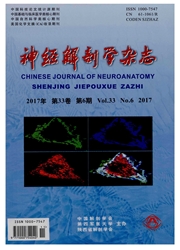

 中文摘要:
中文摘要:
目的:通过研究小鼠嗅球全基因表达差异来寻找嗅球生后发育基因变化及其特征,为嗅球发育及相关研究提供参考依据。方法:分别取新生及成年野生型小鼠完整嗅球并独立进行RNA-seq分析,对全基因测序结果进行差异表达分析并通过检测成年与新生小鼠嗅球中差异表达基因(DEGs),利用Gene Ontology、DAVID及KEGG等数据库,结合q PCR的实验方法对部分差异表达基因进行验证,进一步分析差异表达基因在生物学上的影响。结果:成年小鼠和新生小鼠嗅球存在大量差异表达基因,其中Tfap2e,Neurod6和Tbr1等基因表达下调,同时Zfp365,Elt4以及Omp等基因表达上调,DEGs参与多种信号通路。结论:小鼠嗅球在出生后仍然处于不断发育的过程当中,这些差异表达基因主要影响细胞内代谢,细胞的分裂、分化、成熟及细胞间信号传递。
 英文摘要:
英文摘要:
Objective: To provide some information for research of mouse olfactory bulb by analyzing the difference of gene expression between adult and neonatal mouse olfactory bulb( OB). Methods: Obtaining olfactory bulbs from wild type mouse at adulthood and neonatal stage separately,then performing RNA-seq with these samples individually. After RNA-seq,analyzing the sequencing data and seeking for differentially expressed genes( DEGs) between adult and neonatal samples. Finally,through the Gene Ontology、DAVID and KEGG data analysis,figuring out the biological processes that were affected by those differentially expressed genes. In addition,using q PCR to verify some results of the RNA-seq data analysis. Results: There was huge amount of DEGs that are highly expressed in both adult and neonatal olfactory.These DEGs,and downregulation gene( Tfap2 e,Neurod6 and Tbr1) and upregulation gene( Zfp365,Elt4 and Omp),play roles in many signal pathways. Conclusion: Mouse olfactory bulb is involved in communication of cells and reduced mitosis and there are also a lot of DEGs,which mainly affect metabolism,division,differentiation and maturation of cells and communications during postnatal development.
 同期刊论文项目
同期刊论文项目
 同项目期刊论文
同项目期刊论文
 期刊信息
期刊信息
